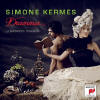Texte paru dans: / Appeared in:
*

International Record Review - (11/2012)
Pour
s'abonner / Subscription information
Sony
88691963952

0886919639520 (ID254)
Consultez toutes les évaluations recensées pour ce cd
~~~~ Reach all the evaluations located for this CD

I first encountered Simone Kermes several years ago in some Handel oratorio recordings on the Dabringhaus und Grimm label. Though she was perfectly acceptable in these, she gave little sign of any exceptional talent for Baroque coloratura singing. Apart from these, all I really knew of her was the occasional video clip of her in concert in which her eccentric stage presence struck me as undignified and I considered her vocally to be a mere one-trick pony, able to deliver rapid coloratura but little else. Then, a couple of years ago, while driving I turned on the radio and heard without introduction the most amazing performance of two of the most extraordinary Baroque opera arias I had ever heard. I could not believe either the ravishing beauty of the music or the exceptional technique of the unknown singer. I was dumbfounded when the announcer revealed I had been listening to extracts from Simone Kermes’s new disc ‘Lava’.
‘Lava’ was soon followed by another Baroque opera arias recital, ‘Colori d’amore’ (reviewed in December 2009 and January 2011 respectively), which continued Kermes ‘s revelation of exceptionally beautiful arias from opera seria of mostly forgotten composers of the high Baroque, many of them connected with Naples. Both are discs I would have trouble not taking with me to the proverbial desert island. They complement her early solo discs of sacred and operatic music of Vivaldi and Handel, which first made Baroque music fans sit up and listen.
With ‘Dramma’, Kermes presents yet more mostly unknown, ravishing arias from the golden age of opera seria (or ‘dramma per musica’ as the librettos of the time often labelled them). Most were written for a celebrated castrato such as Farinelli or Cafarelli. On this disc, she is accompanied by the largely Italian period-instrument orchestra La Magnifìca Comunità, which I think is the best of those Kermes has used in her opera seria recital discs. The CD is designed to look like an LP and the opening track also sounds like one, complete with hiss and crackle, until full glorious sound (though not alas SACD) bursts in at 17 seconds. Although it is an amusing conceit, the novelty quickly wears off.
Kermes’s wide vocal range and her facility with glittering coloratura can be heard immediately in that opening track, ‘Per trionfar pugnando’ by Giuseppe de Majo, which makes astonishing demands both on the singer and two solo trumpets. The already two-and-a-half octave range of the aria is stretched still further in Kermes’s extravagant ornamentation and high cadenzas, matched often note for note by the natural trumpeters, Andreas Lackner and Herbert Walser. In a later track, Porpora’s ‘Se dopo ria procella’, they switch to natural horns and dazzle us all over again in some of the most demanding music ever written for Baroque horn. Apart from the ‘bonus track’ of Handel’s ‘Lascia ch’io pianga’ (odlly with only a little da capo embellishment), the only piece on the disc that may be familiar to modern audiences is Porpora’s sublime ‘Alto Giove’ from Po1ifemo which Philippe Jaroussky has made something of an audience favourite. Kermes’s performance is so silky and serene that Jaroussky, as fine as he is, sounds positively jerky by comparison. This aria and several others, such as Hasse’s ‘Consola il genitore’ (which reduced contemporary audiences to tears) and Porpora’s ‘Tace l’augello’, show that Kermes is just as comfortable in tender, pianissimo arias as she is in those with vocal fireworks.
Unlike many modern singers whose Baroque recitals, for all their excitement, reveal almost complete ignorance of historical style, Kermes has studied the relevant eighteenth-century singing manuals, such as that by the castrato Pietro Tosi. She contributes a detailed and thoughtful essay on vocal style to the booklet, in which she explains the technical requirements of each of the arias on the disc. Her exceptional breath control, subtle use of rubato (or ‘stealing time’, as Tosi called it), mastery of messa di voce and careful application of vibrato are just as important as her celebrated cascading trills in making her today’s most thrilling exponent of late-Baroque opera.
Opera seria has been ignored and derided for over 200 years owing to its extreme artificiality and excess. Yet, well performed it can move and delight us as much as any other great music on drama. The rehabilitation of this noble genre has begun and ‘Dramma’ should play an important part in that project.
Cliquez l'un ou l'autre
bouton pour découvrir bien d'autres critiques de CD
Click either button for many other reviews


